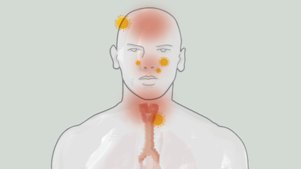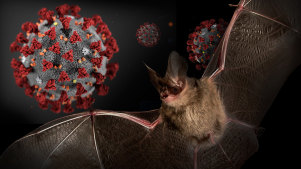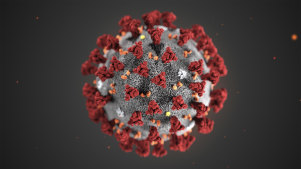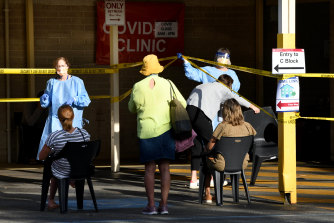Sheryn Groch, in Sydney Morning Herald, 18 March 2020, “How are countries ‘flattening the curve’ of coronavirus?” …. https://www.smh.com.au/national/how-are-countries-flattening-the-curve-of-coronavirus-20200317-p54b3g.html
Large parts of the world are shutting down to stem the spread of a new virus. What measures are working? And how fast should Australia be moving? You can’t see the virus behind the world’s latest pandemic with the naked eye but, plotted on a graph, it looks like one side of a mountain, climbing skyward as case numbers soar past 197,000 people in little more than three months. Eventually, epidemiologists say, that trajectory will start to fall. Immunity in the population will build up against the mystery illness, now known as COVID-19, and it will begin to die out.
But in the middle, there will still be that mountain peak – the curve everyone is talking about. The steeper it is, the more exponential the spread of the virus; the flatter it is, the slower, the less stress on health services, and the more lives that will be saved in the months ahead.
So how do we flatten the curve? What is herd immunity? And what are countries around the world, including Australia, doing to fix the picture?
[wpvideo bFajNygH]
What do we mean by ‘flattening the curve’?
The fight against COVID-19 is about medicine, of course. But it’s also about mathematics (and money). When a new epidemic explodes onto the scene, experts look for two main numbers: how many people each patient will infect and how many people will die from the disease. This helps them plot an arc for the outbreak: how far it will likely spread before a vaccine is rolled out or enough people who have recovered from the illness with virus-fighting antibodies in their system build up “herd immunity” against it.
Flattening this curve means slowing how fast the virus moves through the community. There might still be a lot of cases. But limiting opportunities for the bug to jump from person to person – by adopting “social distancing” measures (such as staying 1.5 metres away from others and avoiding public spaces) as well as improving hygiene and isolating those infected or exposed – will stretch out the spread of COVID-19 over time, giving doctors, economies (and vaccine-makers) space to breathe.
If the curve keeps climbing, we will see a surge of cases needing medical intervention all at once and hospitals will likely run out of life-saving machines such as ventilators, which have been critical in treating patients stricken by more serious cases of the respiratory illness. That would push up the death toll and force impossible triage choices like the ones already facing doctors on the frontlines of the Italian outbreak (where an age limit has even been proposed in intensive care wards to free up beds for a growing number of younger patients in their 40s and 50s).
RELATED ARTICLE

EXPLAINER
CORONAVIRUS PANDEMIC
What does COVID-19 do to the body and what’s it like to have the illness?
Add to shortlist
How is the maths looking for this pandemic?
So far it’s estimated about one in five people infected with the new virus will need medical intervention such as ventilation to recover and about 1 per cent of all patients will die. That’s 10 times higher than the mortality rate for seasonal flu but still much less than the first (and now infamous) coronavirus outbreak SARS in 2003. Unfortunately, the new virus is also more infectious. Each person with COVID-19 is likely to infect two or three people – meaning that growth curve can quickly become exponential, according to the Grattan Institute.
Every day counts once the pandemic clock starts ticking, warns Dr Michael Ryan, who heads up the World Health Organisation’s emergency response team. “Be fast. Have no regrets,” he told the world on March 13. “You must be the first mover. The virus will always get you if you don’t move quickly.”
During the world’s last severe pandemic, the 1918 Spanish flu, the US city of Philadelphia took 14 days to mount a public health response after its first case, even pressing ahead with a big public march. St Louis, meanwhile, cracked down on people’s movement and gatherings within just two days of the influenza strain entering its borders. By the end of the crisis, its death toll was less than half of Philadelphia’s.
How are countries coping with the coronavirus?
Dr Stephen Duckett and his colleagues at Grattan have been tracking the scale and speed of new COVID-19 infections in nations all around the world. Cases might appear in just a trickle at first but, once countries crack the 100 mark, the virus seems to either explode rapidly – such as in China initially, and then Iran, Italy, the US, and Spain – or slow to a flatter line as has been recorded elsewhere including Singapore and Hong Kong. Dr Duckett says nations that moved fast to test and track suspected cases and then brought in tough social distancing or containment measures along the lines of the St Louis model have already seen their infection growth fall, even after rapid early spread.
In lieu of a vaccine, countries from China and Italy to the US and Israel are turning to increasingly medieval methods to stem the tide of the pandemic, closing borders, raising barricades and shutting down much of daily life such as restaurants and workplaces. Other countries like Singapore and Taiwan have brought their case loads under control by getting ahead of the curve early rather than bringing in lockdowns later, ramping up testing, forensically tracing cases back to other people who may have been exposed and making social distancing the norm. (The Philippines has even temporarily quarantined its financial markets, becoming the first country to shut down financial trading in response to the pandemic).
Australia still has comparatively few patients with COVID-19 compared to other parts of the world but our own curve is accelerating. New cases have more than tripled in the past week alone, climbing from 112 on March 10 to 454 as of March 17.
“We’re on the ‘scary’ part of the curve,” Dr Duckett says. “Italy had about the same number of cases on February 26, and now has more than 28,000.”
In places like Italy, patients doubled roughly every two days. This past week, Australian cases doubled about every 3-4 days, Dr Duckett says, putting us on a similar trajectory to the UK and Spain.
The Morrison government has already banned “non-essential” indoor gatherings of more than 100 people, and public events over 500, but so far stopped short of telling people to stay home from work, school or restaurants or off public transport in line with some other countries like the US and the UK. As the outbreak gathers steam, many experts, including doctors, are now asking: why wait?
Prime Minister Scott Morrison says Australian schools, like those in Singapore, will stay open at this stage, based on advice closures would cause unnecessary disruption considering only a tiny fraction of confirmed COVID-19 cases so far have been in children. Health Minister Greg Hunt says we need to adopt a “war-time spirit” and work together to get through the next few months. Of course, under the exponential maths of contagion, that actually means our lives need to take a step (or two) farther apart. Chief Medical Officer Brendan Murphy urges people to think before every physical interaction – washing their hands, cutting out handshaking and kissing hello and keeping clear of others as much as possible. (The US, meanwhile, is telling people to avoid meeting in groups of more than 10 and in Austria that number is down to a cosy five.)
Do lockdowns work? What can China teach us?
COVID-19 first emerged in humans in late 2019, at a wet market in the sprawling city of Wuhan, China. At first, local authorities were perplexed by the mysterious cases of pneumonia and tried to keep them quiet. The illness was not formally linked to a new strain of coronavirus until early January, when millions of people were already travelling for the country’s biggest holiday, Lunar New Year. Infections exploded.
RELATED ARTICLE

EXPLAINER
CORONAVIRUS PANDEMIC
How does an epidemic spread and what does the wildlife trade have to do with it?
Add to shortlist
But then China’s Communist government did something without precedent in modern times – it locked down cities and transport across huge swathes of the country, grounding tens of millions. Factories shut down. Schools and offices closed. Streets emptied.
At the time, such a move seemed unthinkable in a Western democracy (and there are still concerns for those stuck under Wuhan’s enduring lockdown). But, in the maths, it appears to be working. China was clocking up more than 3000 new cases a day in early February. By mid-March, that number had fallen to less than 30. Its government has already claimed “a great victory” over the virus, even as it prepares for a possible second wave. The WHO says the turnaround is a sign the pandemic can still be contained with “aggressive measures”, lashing countries for their slow responses thus far.
But it’s less clear if lockdowns will work for Europe or the Middle East, the next frontiers of the pandemic. In Italy and Iran, early cases appeared to again spread under the radar until a sudden surge hit hospitals (and even Iran’s parliament). Both governments were slow to act; in Iran, for reportedly political reasons. In Italy, the government was at first reluctant to impose such draconian measures on its densely populated cities, like turning soccer fans away from matches or closing bars. But blockades in the north, where the outbreak began, failed to stop infections leaking into the rest of the country – and beyond.
Now Italy has gone into its own style of lockdown (followed by countries such as Spain, France and Germany, as cases in those nations also rise). People are mostly staying home, shops are running on restricted hours and people queuing for supplies must stand 1.5 metres apart. From their windows, Italians in home quarantine sing to each other.
What about surveillance, as with South Korea?
Some experts point out that the two countries which appear to have turned the tide on a rapid outbreak – China and South Korea – have gone further than just lockdowns. Knowing most infections so far have come from close contact in hospitals or family groups, those with (and sometimes without symptoms) are taken out of their homes and put into hospital isolation instead – a move recommended by the WHO. Milder cases are kept together in huge pop-up fever clinics, often in converted stadiums and gymnasiums, and those still being tested kept away from confirmed cases, after old horror stories of infection circulating in SARS quarantine.
RELATED ARTICLE

Both countries, including success stories such as Singapore, Hong Kong and Taiwan, have also been aggressively hunting for cases – temperatures are taken before entering any building. If you have a fever, you must roll up to a specialised clinic or “drive-through” for testing.
These parts of the world have been hit hard by dangerous coroanvirus outbreaks of the past, including SARS, Dr Duckett notes, and so their people were already primed for the health checks to come. When word came from China that another coronavirus had jumped from animals to humans, countries like Singapore and Taiwan acted quickly. Social distancing has since been playing out without need for stricter lockdowns or domestic travel bans. While Hong Kong faced criticism for not closing its borders to mainland China fast enough, months of anti-Beijing protests means schools were already teaching online and many people working from home.
South Korea, meanwhile, saw cases erupt within a religious sect and quickly deployed particularly exhaustive detective work to track down close contacts of known cases– famously using CCTV to trace people back to a specific bus or taxi and even prosecuting those who lied about their movements.
The island nation of Singapore looked in danger of being overrun in February when it was recording the second-highest volume of cases outside China. But it has since flattened its own curve through quick detection and diagnosis as well as strictly enforced home quarantines (featuring spot checks and twice-daily location monitoring with serious penalties applying for a breach.) Meanwhile, countries such as China, Iran and Israel are deploying their notoriously invasive surveillance networks, including tracking phones, to keep tabs on people under isolation and close in on suspected cases.
Australia also has powers to order people into quarantine and some states such as Victoria have started to mobilise police forces to help enforce such orders if required. But other experts including Adjunct Professor at UNSW Bill Bowtell, who helped design Australia’s response to the AIDS crisis, have warned punitive measures will only keep people away from testing clinics.

How important is testing?
WHO director general Tedros Adhanom Ghebreyesus has blasted governments around the world for giving up on widespread testing and contact tracing, “the backbone” of any response, even as they ramp up social distancing measures.
“You cannot fight a fire blindfolded and we cannot stop this pandemic if we don’t know who is infected,” he said on March 16. “Test every suspected case. If they test positive, isolate them and find out who they have been in contact with. And test those people too.”
A lab test for samples of the virus was created quickly. But faster blood tests are still only widely available in China, where diagnosis has been industrialised. At a fever clinic, you will be met by a healthcare worker in full protective gear, testing white blood cell counts and deploying handheld portable CAT scanners to check for the tell-tale “ground glass” inflammation of COVID-19 in the lungs. Even there, a recent study found two thirds of reported cases could be traced back to undiagnosed patients – suggesting the virus could be spreading under the radar even from people with fewer symptoms who shed less virus.
In the US, low testing rates and diagnosis delays from a botched roll-out of intial tests has been blamed for a sudden explosion of cases across Washington, New York and California – many fear the US has since missed its window for containment.
As test kits run low elsewhere, Australia is only testing people considered at risk – either from recent overseas travel, exposure to a confirmed case or, in some cases, an unexplained and severe bout of pneumonia. But aged care residents and doctors with symptoms can now be tested too. Health Minister Greg Hunt insists Australia is still testing more than most countries: 81,000 tests so far, with an additional 97,000 kits set to arrive in clinics.

As shopping aisles empty and self-isolation becomes more common, Beyond Blue CEO Georgie Harman explains how to maintain mental health amid the uncertainty.
What is herd immunity?
The term “herd immunity” has now also gone viral amid speculation Britain’s government was lagging behind other nations in imposing social distancing measures as part of a bold plan to allow the virus to sweep through the population, (and so build up their immunity against it).
In the modern era, community resistance to a virus is commonly achieved through a vaccine. Experts, including in Australia, have warned that stalling protections against COVID-19 for the sake of encouraging natural resistance among “the herd” could be “catastrophic”, costing lives without much slow down.
The United Kingdom still plans to seal off those considered particularly vulnerable to complications from the new virus, including the old, unwell and pregnant women, for three months. But it’s since brought forward social distancing – following the US in announcing new measures warning people to stay home from work and to avoid crowded public places such as pubs and cinemas.
Now the Netherlands has revealed it will embrace a COVID-19 strategy of its own based on herd immunity, saying mass lockdowns are not feasible.
Analysis of virus-fighting strategies by the Imperial College London found targeted measures such as isolating those exposed to the virus or at risk of serious complications could reduce peak demand on hospitals by about two thirds. But researchers noted this would still result in hundreds of thousands of deaths and instead recommended a wider “suppression” where more people in the community stay home.
The problem, as Professor Murphy in Australia has also stressed, is keeping it up over the months ahead without burn out. “You can’t just shut things down for two weeks and that’s it. It has to keep going.”
Let us explain
If you’d like some expert background on an issue or a news event, drop us a line atexplainers@smh.com.au or explainers@theage.com.au. Read more explainers here.

Sherryn Groch is the explainer reporter for The Age and The Sydney Morning Her


A NOTE from MAJOR LALIN FERNANDO = SL seems better organised than US. Attached is from the UK, which initially took a very lais·sez-faire attitude.
https://www.telegraph.co.uk/global-health/science-and-disease/terrifying-data-behind-government-coronavirus-lockdown/
Best